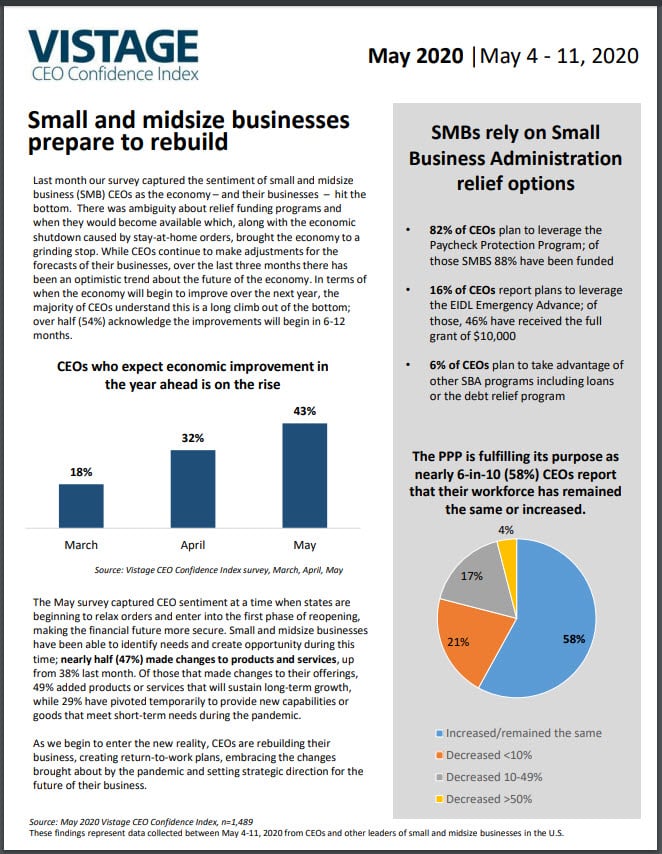Rebuild, don’t repair your business

A Black Swan event is one that comes as a complete surprise and has profound and lasting economic consequences. There is little question that the COVID-crisis fits this description, and that in retrospect we should have seen it coming – the final criteria of how a Black Swan event is defined. It will be years before we can fully assess the economic devastation or impact to individuals and businesses, but there is no question it will be historic.
The economic freefall that took place in March established the new business baseline in April, a baseline that defined the bottom for revenue, customers and employees. With the flattening of the curve, CEOs have begun planning what their businesses will look like on the other side of the crisis and what the new reality might look like. In the meantime, they wait for business activity to pick up and to begin the long and painful climb out of the “COVID ditch.”
Unchartered territory for recovery
There has never been a business or economic crisis like this before. Consequently, there are no best practices, case studies or insightful analysis of exactly what to do. The well-crafted 2020 strategic plans, announced with great fanfare at the start of the year, are all in the literal or proverbial recycling bin. Leaders will need to re-imagine their strategies to ride out “the great wait,” to reboot their businesses and to position themselves for prosperity in the new business landscape that 2021 will hopefully bring.

Just 15% of CEOs indicated their revenues have either remained stable or grown as a result of the pandemic, according to early results of a Vistage survey of small and midsize businesses conducted in early May. This means the majority have faced some degree of revenue declines and are quickly acting to reduce costs, maintain employees, connect with customers and do what they can to support operations. As they look ahead to when business activity begins to accelerate, CEOs need to decide whether to repair or rebuild their businesses.
Repair suggests going back to what worked, what the business was and how it serviced customers in prior social and economic conditions. Repair suggests fixing the business with the assumption that everything will return to the way it was in January 2020.
Unfortunately, there is no going back. The long and difficult climb out of the COVID ditch will lead to a new reality that will be defined by changed human behavior, altered markets, accelerated technology, thirsty competitors and bruised customers, all wanting to grow into the recovery and prosper in the new environment and market conditions.
Rebuilding suggests a fresh perspective based on what’s possible. Rebuilding will bring forward the core strengths and best capabilities of the pre-coronavirus business, but more importantly it will incorporate creative, innovative thinking and factor in societal and market changes. This approach is requisite not just for the retention and growth of existing customers, but also to capture those customers left behind by a failed or weakened competitor. Other opportunities will include expansion into adjacent markets and development of new products and services based on changing customer needs. Opportunity will abound in the new reality provided CEOs can deliver winning strategies to rebuild business.
Blueprints for effective rebuilding
Rebuilding does not mean starting over. Rebuilding starts with taking the core elements of what worked well in the past, and then enhancing and expanding that model with innovation, new capabilities and fresh perspectives. Each area of the business requires special attention.
Rebuilding Talent: We are no longer in a talent war. Small and midsize businesses now face the greatest free-agent market in the history of hiring. Layoffs and furloughs have put many “A” players on the street. Unemployment has spiked to 33 million people with big company layoffs just beginning. While 59% of CEO respondents from our survey have not cut staff, the surplus of talent presents an opportunity to replace poor performers with better talent. For those who have reduced staff, there will be competition for you to recall your top employees since they will have other job options.
Rebuilding Customers: Customers, competitors and markets have all been disrupted by the COVID-crisis. Rebuilding begins with a sharp focus on your surviving customers and what their new requirements might be. As a customer’s business stabilizes, they will look to reward or punish their vendors. This creates opportunity for businesses to secure incremental budget or acquire a new account where a competitor collapsed or failed to perform. Sales execution will be required in either scenario to effectively connect with customers, engage with prospects and assess the market dynamics of the new reality. Many businesses are taking the time now to sharpen the sword, providing their sales personnel with training, and building the skills to help them better identify customer needs and position relevant solutions.
Rebuilding Operations: The behavioral change, adoption and utilization of technology exhibited in just 30 days was equal to 15 years of traditional human change. The newfound appreciation and adoption of technology by the workforce will accelerate the opportunity for businesses to double down on existing technologies that drive productivity as well as invest in new capabilities to power performance. Digital transformation initiatives will accelerate recovery and inoculate the business for future disruptions.
Rebuilding Finance: Whatever the financial, revenue and growth projections were in January, they must be reset to reflect the current business baseline of activity. Prior financial models and historical calculations are meaningless in a COVID-recovery. The great business reboot will reset all metrics and be the base from which growth, cost and profit will be measured. All prior sins and mistakes are forgiven as progress from of the baseline of the COVID ditch will be all that matters. Incorporate rate-of-change data to identify inflection points and be ready to take action.
Rebuilding Culture: Nothing tests a culture like a crisis. Already the top leadership priority of CEOs as identified by our research, the strength of the culture is what holds people together and powers the business forward when everything is uncertain. Once the climb begins, your culture will need to heal from the trauma of the crisis; some coworkers may not return, some customers will be gone, some employees will have suffered personal loss and everyone will need to change for the long climb and the new reality waiting for them.
Leading through the long climb
The climb out of the COVID ditch will require hard, heavy lifting by everyone in the organization to get the flywheel turning again. Business activity will return very gradually as quarantines soften, more people return to work and the economic engines start to turn.
The recovery will happen in a series of small steps as more consumers cautiously return to the market. As jobs begin to return, more consumers will feel comfortable spending again. Virus testing and tracing capabilities will further reduce consumer safety concerns, a prerequisite to buying. Ultimately a vaccine will be widely available and we will have arrived in the new reality.
Leading in a crisis tests CEOs in ways they hadn’t imagined. The spotlight is focused exclusively on them as employees look for answers to their fears. Shifting from crisis to recovery will place a premium on the leader’s vision and ability to see their new reality and the potential it has for the business and its people. After the tremendous effort needed to simply survive the crisis, leaders must engage their employees in the process of rebuilding. It will be a hard climb. Success depends on the leader’s ability to motive their people, inspire a new vision and transform the culture into one that will thrive in the new reality.
Category: Leadership
Tags: Business, coronavirus, Economy

